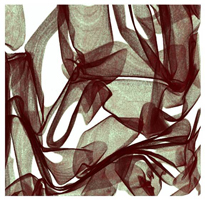
The crumpling or crushing of paper,
aluminum foil, or even a car fender is an everyday occurrence that is
surprisingly rich in new physical and materials principles. Working in the Materials Research Science and
Engineering Center (MRSEC) on Polymers at the University of Massachusetts
Amherst, Menon and Russell used X-ray microtomography experiments on foils crushed into a ball
to understand their detailed 3D structure. These
measurements reveal that the internal 3-dimensional geometry of a crumpled ball
is in many respects isotropic and homogeneous. Crumpling recapitulates classic nonequilibrium problems such as turbulence, where a
system driven by long-wavelength
and low-symmetry forces shows only
rather subtle fingerprints of the forcing mechanism. However, the
researchers found local nematic ordering of the sheet into parallel stacks, a surprising results that will
help physicists and materials scientists better understand these complex
structures. The extent
of this stacking or layering increased with the volume fraction, or degree of
compression. Stacking of the material
into thicker “walls” may be either an alternative or an assistive mechanism to
the formation of ridges, and
impart structural rigidity to the material.